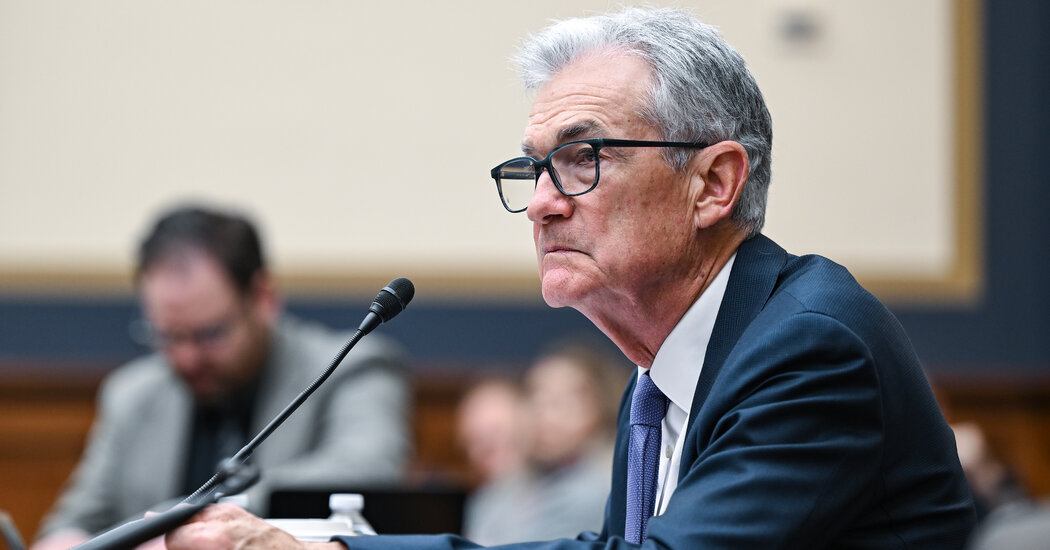April 11, 2024 | by Kaju

America appeared headed for an financial fairy-tale ending in late 2023. The painfully fast inflation that had kicked off in 2021 seemed to be cooling in earnest, and financial development had begun to steadily reasonable after a sequence of Federal Reserve rate of interest will increase.
However 2024 has introduced a spate of surprises: The economic system is increasing quickly, job positive aspects are unexpectedly robust and progress on inflation reveals indicators of stalling. That would add as much as a really completely different conclusion.
As a substitute of the “mushy touchdown” that many economists thought was underway — a state of affairs by which inflation slows as development gently calms with no painful recession — analysts are more and more cautious that America’s economic system just isn’t touchdown in any respect. Fairly than settling down, the economic system seems to be booming as costs proceed to climb extra shortly than ordinary.
A “no touchdown” end result may really feel fairly good to the everyday American family. Inflation is nowhere close to as excessive because it was at its peak in 2022, wages are climbing and jobs are plentiful. However it could trigger issues for the Federal Reserve, which has been decided to wrestle value will increase again to their 2 % goal, a gradual and regular tempo that the Fed thinks is in keeping with value stability. Policymakers raised rates of interest sharply in 2022 and 2023, pushing them to a two-decade excessive in an try and weigh on development and inflation.
If inflation will get caught at an elevated degree for months on finish, it might prod Fed officers to carry charges excessive for longer in an effort to chill the economic system and be certain that costs come absolutely underneath management.
“Persistent buoyancy in inflation numbers” most likely “does give Fed officers pause that perhaps the economic system is working too scorching proper now for price cuts,” stated Kathy Bostjancic, chief economist at Nationwide. “Proper now, we’re not even seeing a ‘mushy touchdown’ — we’re seeing a ‘no touchdown.’”
On Wednesday, Fed policymakers acquired a contemporary signal that the economic system will not be touchdown fairly as easily as hoped. A key inflation report confirmed that costs picked up greater than anticipated in March.
The Shopper Value Index measure hovered at 3.8 % on an annual foundation after meals and gasoline prices have been stripped out. After months of coming down steadily, that inflation gauge has lingered just below 4 % since December.
Whereas the Fed formally targets a separate measure of inflation, the Private Consumption Expenditures index, the contemporary report was a transparent signal that value will increase stay cussed. Days earlier, the March jobs report confirmed that employers added 303,000 employees, greater than anticipated, as wage development stayed robust.
The mixture of robust development and sticky inflation may say one thing in regards to the state of the U.S. economic system, which at any given second will be in one in all 4 conditions, stated Neil Dutta, head of economics at Renaissance Macro, a analysis agency.
The economic system will be in a recession, when development falls and finally pulls inflation decrease. It may be in stagflation, when development falls however inflation stays excessive. It may be in a mushy touchdown, with cooling development and inflation. Or it could actually expertise an inflationary increase, when development is robust and costs rise shortly.
On the finish of 2023, the economic system seemed to be headed for a benign slowdown. However nowadays, the info are much less reasonable — and extra stuffed with momentum.
“You had a variety of chips positioned into the mushy touchdown bucket, and steadily that’s been eroding and chance of an inflationary increase has come again,” Mr. Dutta stated. “That type of strengthened the Fed’s framing, which is that we’ve got time earlier than we’ve got to resolve about reducing charges.”
Fed officers entered 2024 predicting three price cuts earlier than the tip of the 12 months, which might have lowered borrowing prices to about 4.6 % from their present 5.3 %. The officers maintained that decision of their March economic projections.
However as inflation and the economic system general present endurance, traders have steadily dialed again what number of price cuts they’re anticipating. Market pricing means that merchants are actually betting closely on only one or two price cuts this 12 months. Markets additionally count on fewer cuts in 2025 than they beforehand anticipated.
Fed policymakers have taken an more and more cautious tone after they discuss when and the way a lot they could decrease borrowing prices.
Jerome H. Powell, the Fed chair, has repeatedly emphasised that robust development provides central bankers the flexibility to be affected person about reducing rates of interest. In an economic system with a lot oomph, there’s much less of a danger that holding borrowing prices excessive for some time will tip America right into a recession.
A few of his colleagues have been much more cautious. Neel Kashkari, the president of the Minneapolis Fed, has suggested that he might see a situation by which the Fed doesn’t lower charges in any respect in 2024 Mr. Kashkari doesn’t vote on rates of interest this 12 months, however he does sit on the policymaking desk.
Fed coverage drives the price of borrowing throughout the economic system, so that may be dangerous information for households hoping for mortgage or bank card charges to come back down. And it might pose a political downside for President Biden forward of the 2024 election if expensive borrowing prices depart voters feeling worse in regards to the housing market and economic system.
Mr. Biden stated on Wednesday that he stood by his prediction that the Fed would decrease rates of interest this 12 months — an uncommon remark from a president who often avoids speaking about Fed coverage out of respect for the central financial institution’s independence from the White Home.
“This may increasingly delay it a month or so — I’m undecided of that,” Mr. Biden stated.
Many Fed watchers suppose right this moment’s excessive charges might persist for significantly longer. Many economists and traders beforehand anticipated price cuts to begin in June or July. After this week’s inflation report, traders more and more see price cuts beginning in September or later.
Blerina Uruci, chief U.S. economist at T. Rowe Value, famous that the longer inflation flatlined, the extra it might delay price cuts: Officers are prone to wish to see compelling proof that progress towards cooler inflation has resumed earlier than reducing borrowing prices.
And because the chance that the economic system just isn’t actually touchdown looms, some economists and officers counsel that the Fed’s subsequent transfer could even be a price improve — not a discount. Michelle Bowman, a Fed governor, has said she continues to see a danger that “we may have to extend the coverage price additional ought to progress on inflation stall and even reverse.”
Ms. Bostjancic thinks additional price will increase are unlikely at this level: Most Fed officers are nonetheless speaking about cuts. Nonetheless, the latest information counsel that it might take a protracted interval of regular borrowing prices for the economic system to simmer down and for progress towards decrease inflation to restart.
“Extra seemingly, they’re simply going to maintain charges at this degree for longer,” she stated.
RELATED POSTS
View all


